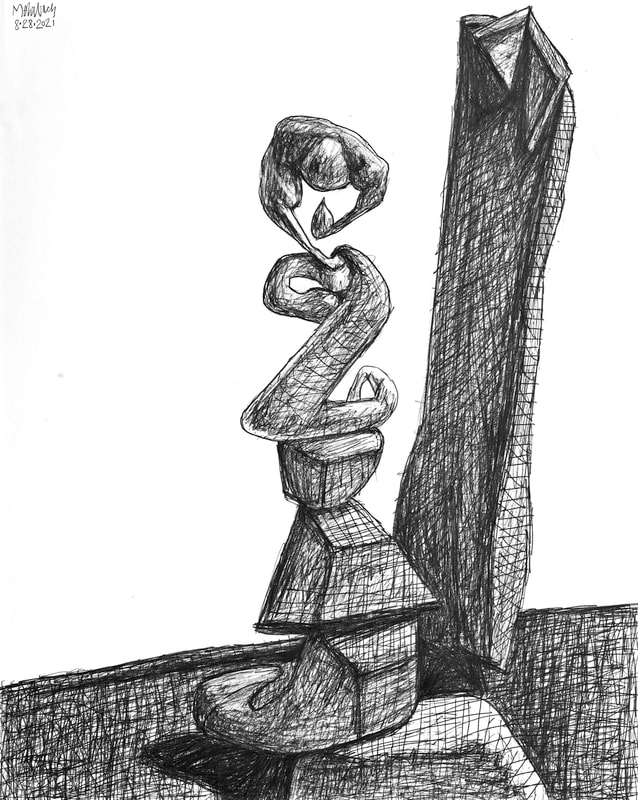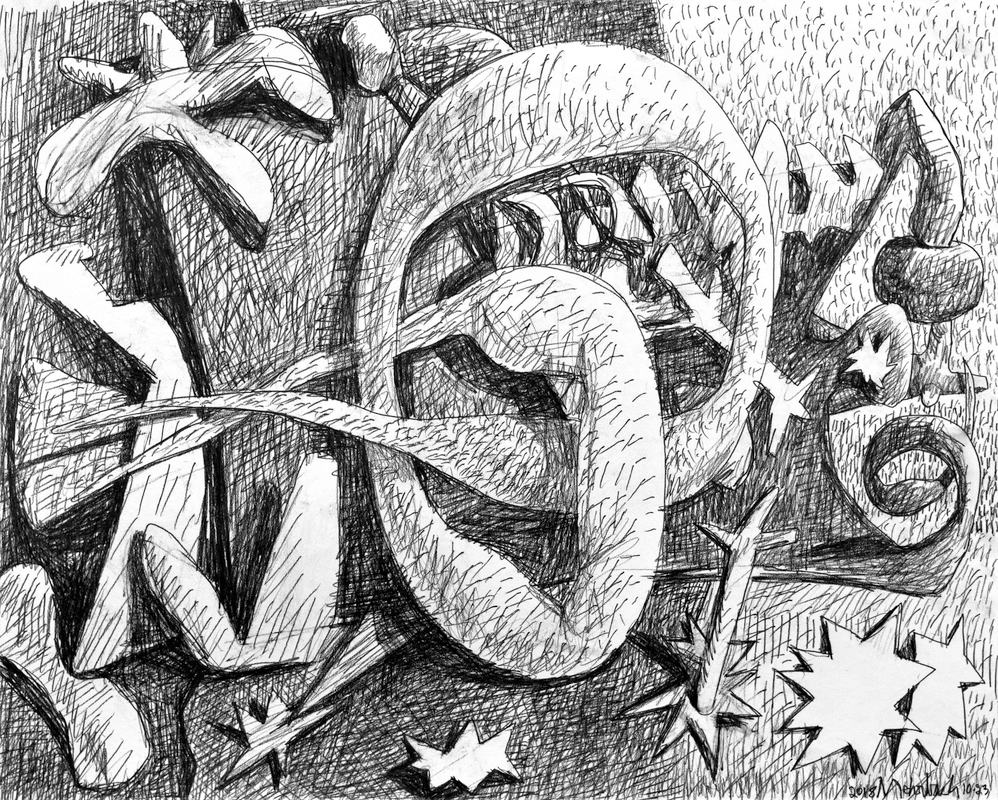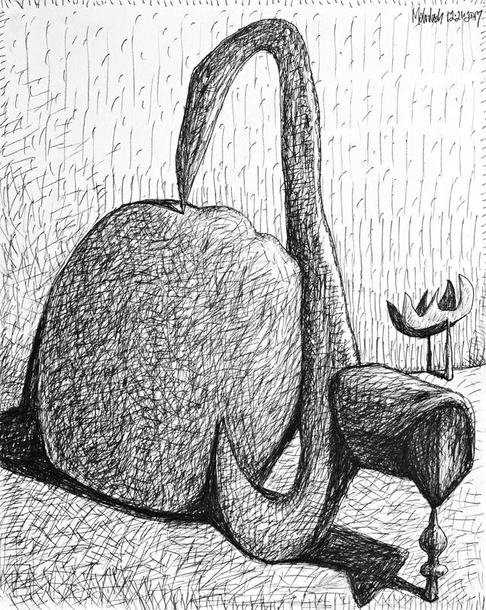 "Silence, Exile, and Cunning" (2022 No.1, state 9), oil on canvas, 49x57 inches, {"I will not serve that in which I no longer believe whether it call itself my home, my fatherland, or my church: and I will try to express myself in some mode of life or art as freely as I can and as wholly as I can, using for my defense the only arms I allow myself to use, silence, exile, and cunning." - James Joyce (1882-1941), "A Portrait of the Artist as a Young Man" (1916)} Yesterday "Silence, Exile, and Cunning" changed; it is incomplete. Everything needs to come together. The discord in the upper left must be resolved.
I am coining a new phrase, Referential Representation. My art-making is most satisfying to myself when my images refer emotionally, and intellectually, to my innermost ideas and feelings. I recognize I feel most successful when I represent my deepest psyche with my images. This full acceptance occurs when my images exhibit references to known forms in my real visual world. These forms are the basic connection we all share, they are our visual reality; as such, they are our visual references to all we know and feel. I believe all abstract art is referential to nature. Nature is in every existing visual form, forms seen in the cosmos, forms seen in our normal-sized everyday living, forms revealed by electron microscopes. forms created by the imaginations of artists, people living today, and those who in the past. I am a compendium of all I have seen.
The drawings I show you today are successful because they are Referential Representation. This is what I feel and this is what believe. These images are me reacting to newfound questions. I allow myself to act, react, making real. I simultaneously accept classical composition as mandate, and my receptiveness to questions. I accept The Classical Mandate, i.e., in-your-face engagement is the simplest, and purest, conduit to viewer attention. In yesterday's blog I showed three image by Philip Guston. Those images follow The Classical Mandate. Picasso accepted The Classical Mandate. I have, at last, accept The Classical Mandate. I accept the necessity of immediate, in-your-face, attention grabbing imagery. It is the necessity to engage the viewer; it is necessary in every composition. After you look at my work, constructed with The Classical Mandate, look at one of Picasso's works (below👇). In his earliest work, and in his last, Picasso accepted The Classical Mandate. It took me a while, but I am here now. There is no denying The Classical Mandate is effective. Acceptance of tried and true is a comfort. It allows me to expand self-expression. It is the fluid means to self-engagement? The bonus is engagement with the viewer. After all, communication, between artist and viewer, is the ultimate goal. Yesterday's drawing is worth its try. I am looking to excite the entire two-dimensional surface. I'm looking to engage emotions upon first site. The insistence of two-dimensionality, which is true for all wall-hung objects, is undeniable. I have tried to deny that, but the hour is getting later; I want to express now, not later. So, here they come. One after another; I am going to hurl images at the viewer, all in acceptance of my human-ness, reality, and my angst. I want to be here to stay, but I know that cannot be true. Full acceptance is pictorial two-dimensional acceptance; 2D limitations embrace both space and time. I live in a 3D human world where 2D images hang on our walls. Okay, I accept it! Now, here come the real. I am fully aware that the greatness of Pablo Picasso began in his youth. Early on in his artistic life, Pablo accepted the limitations of space and time; his acceptance occurred far earlier in his life than my acceptance of the same. From my earliest days I rebelled against limitations. Pablo accepted the reality of limitations, then he worked within those limitations to create amazingly disparate images. I show you one (below), because it is related to the drawing I created yesterday. My methodology is more multi-think than Doublethink. This concerns me. I worry I see in a complicated and complex manner. I worry this makes it difficult to communicate through my art. Am I allowing myself to solve the needs of an image by multitasking the image? Instead, should I be simplifying my images toward their basic instincts? When I began the new painting, "Doublethink", I had ambition; I wanted restrict it to two contradictory and contrasting forms. Obviously this did not happen in state 1. You can see "Doublethink" as two contrasting areas; the left playing with rectangular in/out rotational vigor, the right with rounded up/down spinning-top-like verticality. I am not sure I will work on "Doublethink" again today. I need its complexity to percolate within/without me. There is a very complex drawing on my drawing board right now. It waits for me to solve it, to finish it off. I began this drawing with thoughts similar to those I began "Doublethink". My thoughts were similar in their simplicity-seeking. The drawing ran away toward a self-imposed complex solution. It feels self-imposed by the drawing, but of course it is me. It is me who is self-trained to see this way. This morning, in my effort to question my complexity, I purchased a sketch book. I hope it will help me resolve my issues with myself. I will use the sketch book to experiment with different ways to tackle by complex-seeing personality. I believe I am in need of simplification. I could be wrong.
My knowledge is converging into my artistic personality. My artistic personality is a revelation of myself. I do not want my art to be simple manifestation of id. I want it to measure self-discovery deeper than instinct, deeper than my primary intellectual and emotional processes. This is about me finding the reason I am; the reason I exist; the reason my actions have meaning beyond action itself. I know my being has importance. Everyone has importance. Me, the artist, wants to manifest my reason to live through visual imagery. The game I play is this: I actively reveal myself to myself; I make the effort to communicate that revelation to my viewers. We have commonness in self-worth. I am hoping my art allows us to be together, to simultaneously be uplifted by self-glorification. Our existence has value; it has significance because it is consequential.
Yesterday's drawing is immensely important to me. It gathers accumulated knowledge through deep-rooted conversation with myself. I did this in the act of making it. It is simultaneously the convergence of knowledge and the creation of new knowing. This is the process I define as art-making. Given my discussion today I believe I have made a larger discovery. The current art market revels in found images, i.e., images made by Banksy, Jeff Koons, and (from the the past) Andy Warhol. My art is vastly different in concept; different from those successfully marketed artists. It is not about simple images defined by our cultural camaraderie. It is about images that are layered with nuance of selfness. I am making an effort to pare down the complexity of my images. They are often made by forms being added to balance off forms already there. This leads to compositions balanced by complexity of means. Such activity-style is convoluted. I am trying to make images more closely fit my intuitively known emotional/Intellectual self.
I am not explaining this well. An analogy is this: If a device can be built in a myriad of ways, it must certainly be better to build it with fewer parts. The more parts the more chance it will mis-perform, perhaps even do something it was not intended to do. It might break completely; its intended function may be lost. Obviously, a quest for simplicity of means in visual art is best. Simple is more efficient, and the intended communication is more likely to be successful. Yesterday's drawing, in the making, began with a simple hook to bring me in. After I was in I enriched it! This makes sense to me, as the hook gets the viewer's attention, then the sensual subtleties allow one to dwell, like a complex taste on one's palate.
Over and over, look after look, I have been seeing a problem in my drawing from July 18 (Blog post of July 19). I fixed it. What bothered me was the shadow cast by the form in its upper left. It amazes me how a subtle alteration creates an enormous change in the impact of the image. It makes more sense, and rests easier, true and real. That is important, since without realism in abstraction the image looks awkward and unseemly. Below is current state of the July 18 drawing. The disjunction between the left and the right of the painting "2017 No.3" horrifies me. Is that good? Is that the right emotion? Intuitively I think it will beget a better response if I place a spot of red on the left side. I do use Ivory Black, which is a warm black. That helps, but it begs for more warmth. Tried and true color theory says the color wheel implores completion. The primary color missing in this painting is red. Adding red is a comfortable solution. Adding a spot of red would reduce this painting's discomfort, but is it the right thing to do? Yesterday's drawings also utilize separate panels within one image. I have always been interested in multiple panels, multiple images, for several reasons. Disparate images request intellectual and emotional unification. Viewers do this spontaneously. The human mind questions without reservation. This absolute need to put together the most disparate of ideas intensely engages the viewer. It is NOT a new idea. Several artists of my generation have done this, none more repeatedly than David Salle [below are reproductions of two of Salle's works, one early in his career (1983), and one from 2016]. Notice, in Salle's paintings the color wheel is comfortably completed, making more comfortable the disparate images. |
To read my profile go to MEHRBACH.com.
At MEHRBACH.com you may view many of my paintings and drawings, past and present, and see details about my life and work. Archives
July 2024
|


















 RSS Feed
RSS Feed